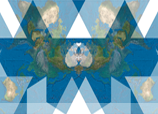The Center for Design and Geopolitics is a think-tank based at Calit2 and the University of California, San Diego devoted to using Art and Design to develop new models for how planetary-scale computation transforms political, urban and ecological systems. D:GP was founded in 2010 by Visual Arts professor, Benjamin H. Bratton.

DESIGNING GEOPOLITICS 2 CONFERENCE,
JUNE 2, 2012
Designing Geopolitics 2, will be the second conference event of D:GP. The event will be held June 3, 2012 at Calit2 at UCSD. The event will feature artists, designers, scientists and programmers working across disciplinary boundaries to prototype alternative infrastructures. The event is open to the public.
More information


DESIGNING GEOPOLITICS 1 CONFERENCE,
JUNE 3-4, 2011
D:GP's first annual conference featured 25 speakers from 19 different disciplines. How does a digital Earth govern itself? Through what jurisdictions, what rights of the citizen-user, what capacities of enforcement, and in the name of what sovereign geographies? We need to design that geopolitics.
See Conference Videos


BENJAMIN H. BRATTON
D:GP's Director is Benjamin H. Bratton, Professor of Visual Arts at the University of California, San Diego. His work sits at the intersections of contemporary social and political theory, computational media & infrastructure, and architectural & urban design problems and methodologies.
See bratton.info


DEEP ADDRESS
This D:GP research track explores the technical and philosophical potential of very fine grain universal addressing systems (such as IPv6) to provide, not only a framework for ubiquitous computing, but for new forms of communication across physical scales, from cells to climate systems and back again.


"THE ART & THEORY OF PLANETARY COMPUTATION"
In this interview, D:GP Director Benjamin H. Bratton discusses the Center's research program, planetary-scale computation, political geography, cloud computing, Google/China, and new geopolitical boundaries.


D:GP BLOG
D:GP's ongoing commentary on events, ideas, projects, and innovations directly related to our research, and to the intersections of new design disciplines and the challenges of rethinking geopolitics for the age of planetary computation.


NANOSKIN
This project, part of D:GP's "User" track, is a collaboration with Nanoengineer, Dr. Joseph Wang, and explores new applications of Wang's "bio-tattoos" which can sense particulate matter in the environment and extend the perceptual capacity of individual skin and surfaces.


"THE STACK"
The theoretical work of the Center is being developed into a specific model of planetary computation and political geography, called "the stack," and based on the vertical, sectional structure of software stacks and multi-layered networks. View related lectures. Book version forthcoming.


D.E.E.D.
Part of the "network" research track, The Digital Energy and Environmental Design standard builds on the LEED standard for sustainable building to explore ways in which information systems in specific physical environments structure the terms of vibrant and "socially sustainable" forms of interaction.


WESTPHALIA 2
How have planetary computation, ecological crisis and networks of migration distorted the traditional geography of the nation-state and what alternatives are possible to subdivide planetary territory and jurisdiction? This project literally draws those alternatives and considers them as possible models for rethinking systems governance.




